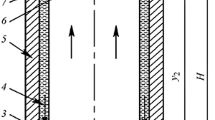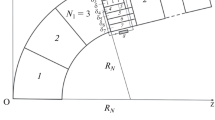Abstract
Numerical analysis of thermal conditions for a two-phase closed thermosyphon using the ANSYS FLUENT software package has been carried out. The characteristic temperature distribution, streamlines and velocity vectors for various heat loads have been obtained. The study has found the possibility of using the software package for analysis of the energy transfer processes at high thermal loads.
Similar content being viewed by others
References
Ten’kovtsev, V.V. and Tsentner, B.I., Osnovy teorii i ekspluatatsii germetichnykh nikel’-kadmievykh akkumulyatorov (Fundamentals of the Theory of Operation of Sealed NCBatteries), Leningrad: Energoatomizdat, 1985.
Khrustalev, D.A., Akkumulyatory (Rechargeable Batteries), Moscow: Izumrud, 2003, pp. 183–186.
Klyuev, N.I. and Bruyaka, V.A., Liquid Film Disruption in Horizontal Liquid-Metal Heat Pipes with Netted Capillary Structures, Izv.Vuz. Av. Tekhnika, 2004, vol. 47, no. 1, pp. 33–35 [Russian Aeronautics (Engl.Transl.), vol. 47, no. 1, pp. 50–53].
Klyuev, N.N. and Muryskin, A.V., Hydrodynamic Model of Film Liquid Evaporation on a Cylindrical Wall, Izv.Vuz. Av. Tekhnika, 2012, vol. 55, no. 4, pp. 49–51 [Russian Aeronautics (Engl. Transl.), vol. 55, no. 4, pp. 392–396].
Chan Ho Lee, Sang June Bae, and Minyoung Jang, A Study on Effect of Lithium Ion Battery Design Variables upon Features of Thermal-Runaway Using Mathematical Model and Simulation, Journal of Power Sources, 2015, vol. 293, pp. 498–510.
Rim Saada, Dipesh Patel, and Basudeb Saha, Causes and Consequences of Thermal Runaway Incidents–Will They Ever Be Avoided?, Process Safety and Environmental Protection, 2015, vol. 97, pp. 109–115.
Song, Tao, Li, Yan, Song, Jiashan, and Zhang, Zhao, Airworthiness Considerations of Supply Chain Management from Boeing 787 Dreamliner Battery Issue, Procedia Engineering, 2014, vol. 80, pp. 628–637.
Slayton, R. and Spinardi, G., Radical Innovation in Scaling up: Boeing’s Dreamliner and the Challenge of Socio-Technical Transitions, Technovation, 2016, vol. 47, pp. 47–58.
Klyuev, N.I. and Bruyaka, V.A., Mathematical Model of Liquid Film Damage in the Counterflow Thermosiphon, Izv.Vuz. Av. Tekhnika, 2003, vol. 46, no. 1, pp. 58–60 [Russian Aeronautics (Engl.Transl.), vol. 46, no. 1, pp. 93–96].
Bezrodnyi, M.K., Pioro, I.L., and Kostyuk, T.S., Protsessy perenosa v dvykhfaznykh termosifonnykh systemakh (Transfer Processes in the Two-Phase Thermosyphon Systems), Kiev: Fakt, 2005, p. 704.
Kuznetsov, G.V. and Sitnikov, A.E., Numerical Analysis of Basic Regularities of Heat and Mass Transfer in a High-Temperature Heat Pipe, Teplofizika Vysokikh Temperatur, 2002, vol. 40, no. 6, pp. 964–970 [High Temperature (Engl.Transl.), vol. 40, no. 6, pp. 898–904].
Kuznetsov, G.V., Al-Ani, M.A., and Sheremet, M.A., Numerical Analysis of Convective Heat Transfer in a Closed Two-Phase Thermosyphon, Journal of Engineering Thermophysics, 2011, vol. 20, no. 2, pp. 201–210.
Kuznetsov, G.V. and Sheremet, M.A., Two-Dimensional Problem of Natural Convection in a Rectangular Domain with Local Heating and Heat-Conducting Boundaries of Finite Thickness, Izv.RAN. Mekhanika Zhidkosti i Gaza, 2006, no. 6, pp. 29–39 [Fluid Dynamics (Engl.Transl.), vol. 41, no. 6, pp. 881–890].
Kuznetsov, G.V. and Sheremet, M.A., Conjugate Natural Convection in an Enclosure with a Heat Source of Constant Heat Transfer Rate, International Journal of Heat and Mass Transfer, 2011, vol. 54, nos. 1–3, pp. 260–268.
Asghar Alizadehdakhel, Masoud Rahimi, and Ammar Abdulaziz Alsairafi, CFD Modeling of Flow and Heat Transfer in a Thermosyphon, International Communications in Heat and Mass Transfer, 2010, vol. 37, no. 3, pp. 312–318.
Shaidurov, V.A, Shchepanovskaya, G.I., and Yakubovich, M.V., Numerical Modeling of Flows of a Viscous Heat-Conducting Gas in a Channel, Vychislitel’nye Tekhnologii, 2013, vol. 18, no. 4, pp. 77–90.
Author information
Authors and Affiliations
Corresponding author
Additional information
Original Russian Text © A.S. Krasnoshlykov, G.V. Kuznetsov, published in Izvestiya Vysshikh Uchebnykh Zavedenii, Aviatsionnaya Tekhnika, 2017, No. 2, pp. 82—86.
About this article
Cite this article
Krasnoshlykov, A.S., Kuznetsov, G.V. Mathematical modeling of thermal modes of thermosyphons in operation with characteristic heat loads of aircraft equipment batteries. Russ. Aeronaut. 60, 251–256 (2017). https://doi.org/10.3103/S1068799817020143
Received:
Published:
Issue Date:
DOI: https://doi.org/10.3103/S1068799817020143




